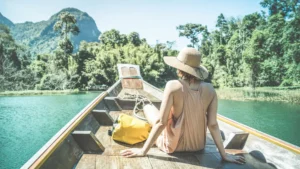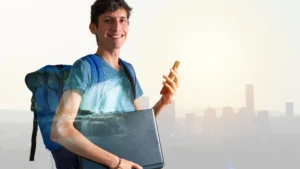Whether you’re exploring Bandar Seri Begawan in Brunei or picking your way through Luang Prabang in Laos, the realities of traveling in Southeast Asia all boil down to money: how much you have, how you’re spending it, and how much you’ve got left.
The smarter you spend your money, the more you’ll be able to enjoy the local culture, the more ground you’ll cover transportation-wise, and the more you’ll get out of your trip overall. The tips here represent some of the best ways to maximize your travel purse: allowing you to make the right choices about transportation, money changing, and dining.
Transportation: Cheaper Alternatives to Airlines
Budget airlines have reduced travel times across Southeast Asia without increasing budgets too much – but what if you simply can’t afford to travel by air, or just want to have more spending money left over for ground-based activities?
The hidden costs of flying even budget airlines can mount over time, Sam and Natalia of Something of Freedom tell us. “Flying often incurs extra costs such as baggage fees and transport to/from the airport at each end of your journey,” they say.
You can simply do what backpackers in Southeast Asia have done for decades: book a bus or ride a boat or ship.
Bus travel in Southeast Asia. Sam and Natalia call buses “the most cost effective method of travelling South East Asia.” Travel on popular long-distance routes like the highway connecting Phnom Penh to the temple town of Siem Reap, and you can bid many of the hidden costs of flying goodbye: “buses carry your bags at no extra cost and terminals are generally more centrally located – saving you transport costs.”
Buses can also save you on accommodation costs too. “Night buses are the way to go,” they tell us. “Not only will the journey seem quicker if you sleep through it, but you won’t have to pay for a night’s accommodation.
“Why waste a day of your trip sat on a bus when you could be exploring new places? Night buses will save you money whilst maximising the time you have in each place!”
Ferry travel across the water. For some roads, buses are out of their depth (literally). “What if a country consists of thousands of islands like Indonesia or the Philippines?” ask Campbell and Alya of Stingy Nomads. “In this case, local ferries are a good public transport option.”
they go on more or less regular base (depending on weather conditions and destination), they are cheap and offer you a great chance to experience real local way of living.”
Campbell and Alya are self-confessed ferry fans – “We used them a lot around South-East Asia,” they tell us. “For most destinations you don’t need to book anything in advanced there is always a spot available. Some of the ferries have even AC rooms and TVs but just to sit on a deck and enjoy the beautiful scenery while drinking local coffee or tea is a real pleasure.”
Buses and boats both have one downside that you should take into consideration. “One important thing to keep in mind is time,” Campbell and Alya tell us. “If you’re in a hurry and need to get somewhere quick this way of moving around can be quite frustrating!”
Rent a bicycle and explore by yourself. Once you’ve arrived, do you put yourself at a local tuk-tuk’s mercy? For Elaine & Dave of The Whole World is a Playground, taking private local transport can drive costs up fast. Instead, the traveling couple suggest you strike out on your own two feet, er, wheels.
“Renting a bike to explore the sights is a fantastic way to save money on a trip,” Elaine and Dave tell us. “Consider renting an electric bike, a lifesaver when temperatures are high and the distances long in the South East Asia midday sun.”
Beyond cost considerations, riding bikes can be great fun for the active traveler. “Some of our favourite memories from South East Asia are [on a bike] – cruising along the Myanmar roads at dawn on our way to watch the sun rise over the Bagan temple plain,” say Elaine and Dave. “We saved money, were able to do our own thing and had fun doing so!”
How to Save on Foreign Exchange
Melissa Delaware of Thrifty Family Travels advises weighing the pros and cons of buying local currency and using your ATM when traveling.
“If you purchase SEA currency before you leave home, you will be stung with commission fees and crappy exchange rates,” Melissa says. “You also risk the case that if you don’t spend all that foreign currency, you will have to exchange it back to your own currency when you return home getting hit with fees again.”
Your alternative – withdrawing from a local ATM using your bank card – runs another set of risks. “Most banks will charge ridiculous fees and there is also the poor exchange rate again,” Melissa says. “The other problem is that usually you can only withdraw a small amount of money in SEA so you will need to withdraw money multiple times, increasing the fees again.”
However you decide, Melissa advises travelers to manage the amount of cash they bring when they walk around the destination. “For me, I usually keep the money in multiple places on my person as well as hidden in bags and the hotels’ safe,” she says. “When you are sightseeing, only bring the cash you need and leave the rest behind.”
How to Save on Food & Drink
Drinking water represents a surprisingly large hidden cost for travelers to Southeast Asia – blame the heat and humidity. “We all probably drink more than the prescribed two litres of water a day when we’re in South East Asia,” says Sarah Carter of A Social Nomad. “Most people buy it in bottles.”
Plastic bottles have both a cost and environmental impact: “The average cost of a 2-litre bottle of water is US$0.65 in Thailand, US$0.55 in Indonesia and US$0.72 in Malaysia – that’s US$57 every 3 months just for drinking water and brushing your teeth!” Sarah says. “Then there’s the huge environmental cost of all those plastic bottles that you’ll throw away.”
Sarah suggests drinking local tap water, cleansed with a filtration device like the Drinksafe Travel Tap. “This is a light but robust drinking bottle with a replaceable filter,” Sarah says. “It removes 99.9% of viruses, protozoa, anthrax and pathogens. It’s used by disaster relief teams and the British Army.”
To ensure effectiveness, Sarah uses a SteriPen that flashes pathogen-killing ultraviolet light. “This destroys over 99.9% of bacteria, viruses, and protozoa like Giardia and Cryptosporidium,” Sarah explains. With both methods, Sarah says, “we’ve saved thousands of dollars by doing this while staying healthy.”
Eating buffet-style. It goes by many names, but whatever you call one, a “curry canteen” or “economy rice”, these cheap dining spots offer “one of the cheapest and best value eating options in ASEAN,” says Live Less Ordinary’s Allan Wilson, “canteen-style buffets which serve rice with a variety of hot pre-cooked dishes and other sides.
(These are distinct from Singapore’s hawker centers, another famously cheap-but-good food option that instead relies on individually-cooked dishes, instead of a buffet-style spread.)
“These are popular lunch-time options with traffic from the local businesses and offices, found at almost every food court, so it’s best to get there between 11:00AM -12:00PM before the hungry hoards take all the best bits,” Allan says.
Allan swears by Malaysia’s “economy rice” (and variants thereof) as offering the best flavor and value of the lot. “These buffets can offer 10s to 100s of curry options, with both Indian influences in Nasi Kandar, and Malay and Chinese influences in Nasi Campur buffets,” he enthuses.








